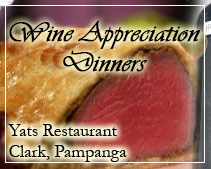Grapegrowers Face Herbicide-Resistant Weeds- 11June24
Davis Weed Day to detail challenges and strategies; survey seeks grower input by Jon Tourney
Davis, Calif.ŌĆöWeed resistance to herbicides is increasingly a concern in California vineyards; several weed species are reportedly resistant to the glyphosate-based herbicides commonly used in vineyards. Scientists at the Weed Research and Information Center (WRIC) at the University of California, Davis, are studying this key issue and requesting grower input via an online survey. Herbicide resistance will be featured a topic at the annual Weed Day on the UC Davis campus July 14. Dr. Brad Hanson, cooperative extension weed specialist for vineyards and orchards in the Department of Plant Sciences, chairs Weed Day 2011. Hanson performs field research at UC Davis, at the UC Kearney Ag Center in Fresno County, and in cooperative projects with commercial growers. His research includes evaluating new and existing products for chemical weed control, herbicide-resistant weeds and assisting county farm advisors and growers with weed management strategies. Hanson told Wines & Vines, ŌĆ£WeŌĆÖre seeing problems with glyphosate resistance, and I suspect we will see more.ŌĆØ Glyphosate is the active ingredient in Roundup, Touchdown and several other post-emergent or ŌĆ£contactŌĆØ herbicides. It is normally sprayed on young, small weeds, acting as a ŌĆ£burn-downŌĆØ agent on green tissue. In vineyards, it is commonly used to control in-row, under-vine weed growth. Monsanto, producer of Roundup, lost its patent on glyphosate in 2000, opening the door for competing and more economical generic glyphosate products. Hanson explained, ŌĆ£The price has dropped for glyphosate herbicides, and they are generally considered to have low toxicity, so there are a lot of incentives for growers to use them.ŌĆØ Glyphosate is the most-used herbicideŌĆöboth in California vineyards and worldwideŌĆöand it accounts for an estimated 41% by weight of all herbicide use in California crops. Hanson produced a chart of California herbicide use reported in grapes for 2009, listing the top 10 herbicides by their active ingredients and the number of acres treated. These figures apply to all grapes (wine, table, raisin) planted statewide in 2009, a total of 786,000 acres. Active ingredient Typical brands Acres Herbicides Used on California Grapes, 2009 Glyphosate Roundup 204,000 Glufosinate Rely 147,000 Oxyfluorfen Goal, Goaltender 59,000 Paraquat Gramoxone Inteon 49,000 Pendimethalin Prowl 48,000 Flumioxazin Chateau 44,000 2,4-D — 25,000 Oryzalin Surflan 23,000 Rimsulfuron Matrix, Mana 21,000 Trifluralin Treflan 11,000 Glyphosate-resistance has been found in California weeds including hairy fleabane (Conyza bonariensis), horseweed or mareŌĆÖs tail (Conyza canadensis), Italian ryegrass (Lolium multiflorum), rigid ryegrass (Lolium rigidum) and junglerice (Echinochloa colona). Hanson said these weeds are more commonly found in the Central Valley, but hairy fleabane is also found in the North Coast and Central Coast. There is also concern about glyphosate resistance with barnyardgrass (Echinochloa crus-galli), Johnsongrass (Sorghum halapense) and annual tall willowherb (Epilobium brachycarpum); the latter is now a problem in Napa Valley vineyards. ŌĆ£A high proportion of vineyards are sprayed with glyphosate two or more times during the year,ŌĆØ Hanson said. He recommended rotating applications of herbicides with different modes of action (MOA) to increase efficacy and reduce the development of weed resistance such as using a glufosinate in place of a glyphosate application or using a pre-emergent in the fall. Using different cultural practices is another option. In the case of fleabane and horseweed, Hanson said, ŌĆ£These weeds donŌĆÖt tolerate disturbance very well, so they would not likely be found where mechanical weed control is used. They are more often seen in untilled berms.ŌĆØ For general weed control practice, Hanson recommended, ŌĆ£People should scout their fields regularly to know what the weed problems are, to know if new weed species are emerging or if weed populations are shifting.ŌĆØ He added, ŌĆ£ItŌĆÖs common to see a flush of new growth after a rain event, and some weeds can emerge almost any time of year.ŌĆØ Hanson noted that itŌĆÖs important to control weeds before they reproduce and add to the weed seed ŌĆ£bankŌĆØ in the soil. Preventing the spread of weeds and seeds is another consideration. Practices now used to clean and sanitize vineyard equipment to prevent the spread of pests between vineyards could also be used to help prevent the spread of problem weeds. Survey seeks grower input Hanson is asking for input from grapegrowers in an online survey he launched this month as pa rt of a larger statewide project, ŌĆ£Evolution and Management of Herbicide Resistant Weeds.ŌĆØ He hopes to obtain information from 1,000 California growers, ag managers, PCAs, etc., who deal with weed management in vine and tree crops. Contribute to the web-based survey at ucanr.org/hrwsurvey; it will be open through February 2012. Results will help with future research directions and extension education programs regarding production inputs and management of weeds in perennial crops. Hanson observed, ŌĆ£The survey information will give us a good understanding of the perceived problems with resistance and will couple with the physical testing of weeds we are doing around the state.ŌĆØ Weed Day program Weed Day 2011 will include a morning field day program to look at research projects on campus and afternoon classroom sessions following lunch. Information and registration is at wric.ucdavis.edu/events/weed_day_2011.htm. Hanson said, ŌĆ£Weed Day also offers the opportunity for informal discussions with plant scientists, growers, PCAs and chemical product representatives for two-way interaction that can be very valuable.ŌĆØ Although the program covers a wide spectrum of weed-management issues for the gamut of agricultural crops and aquatic and rangeland environments, several sessions will be of interest for vineyard managers: ŌĆó A demonstration on the effects of spray coverage and nozzle selection on contact herbicide efficacy. ŌĆó Control of panicle willowherb in Napa Valley Vineyards by John Roncoroni, UC extension weed science farm advisor in Napa County. ŌĆó Herbicide resistance: comparison of glyphosate resistance to other cases of resistance. ŌĆó Investigating the mechanism of glyphosate-resistant junglerice. (Hanson said junglerice is beginning to be found in some Central Valley vineyards, and there is concern it could spread more widely.) Registered herbicide list Another Hanson project is annually updating and posting a chart of all current California-registered herbicides (based on the active chemical ingredient) for use in vine and tree crops. Hanson plans to update the list each fall and noted that updating is important. New products are constantly being tested for introduction, and older products sometimes lose their registration due to safety or environmental issues. See the current list, compiled in February 2011, here. The grape list has 12 pre-emergent herbicides and two others for use only in non-bearing vineyards. Ten post-emergent herbicides are on the list, and three others for use only in non-bearing vineyards. The list includes two organic post-emergents: d-limonene (GreenMatch), and clove oil (Matratec). WRIC resources and the Hanson blog The WRIC posts useful resources for growers on its website, including a list of UC weed scientists and farm advisor weed specialists throughout California, a database of weed susceptibility to herbicides and links to pages with information about specific weeds and control options. Another feature is an interactive ŌĆ£Weed Identification Tool.ŌĆØ This enables users to key in physical characteristics about a weed by answering a series of questions with choices; eventually theyŌĆÖll arrive at the weedŌĆÖs name, or a short list of weed names that fit the description. Photos confirm identification. Hanson stressed the importance of proper weed identification and pointed out, ŌĆ£Unknown weeds cannot be properly managed.ŌĆØ Weed publications and reference guides can be ordered through the website, including ŌĆ£Weeds of California and other Western States,ŌĆØ authored by WRIC director Joseph DiTomaso. Last year Hanson started a UC Weed Science blog that contains updates, discussions and links to articles on weed control, management and ecology. Access it at ucanr.org/blogs/UCD/WeedScience/, or through the WRIC website. (EditorŌĆÖs note: Also see Glenn McGourtyŌĆÖs Wines & Vines column on ŌĆ£The 10 Weeds You DonŌĆÖt Want to Know,ŌĆØ December 2009)
Source: http://www.winesandvines.com/template.cfm?section=news&content=89230&htitle=Grapegrowers%20Face%20Herbicide-Resistant%20Weedshttp://www.winesandvines.com/template.cfm?section=news&content=89230&htitle=Grapegrowers%20Face%20Herbicide-Resistant%20Weeds
TRAILER 4
With new golf courses springing up in and around Clark Philippines and an ever-increasing patronage by tourists from neighboring South Korea, Clark Freeport is short on hotel accommodation.
Even with the addition of 27 holes in 2009 and 2010, there is an acute shortage golf tee times for at least 5-6 months each year. Local players compete with frustrated (golf) tourists from Korea and China for tee times. Unfortunately Clark Philippines doesnŌĆÖt have the luxury of vast tracts of land suitable for this type of development.
Mimosa offers 36 holes of championship golf, visitors can pay and play, busy during the weekends but not that difficult to get on or join up with a group to form a 4-ball. The new FAKCC offers 27 holes of world-class golf.
What many tourists and residents of Manila, Subic, Pampanga Angeles City and Clark Philippines found out over the holidays when they traveled out of town going north to Pampanga for a short getaway and a nice vacation was that there is a highly recommended hotel in Clark is also a very night out place.
This web site contains articles and information that will be helpful to visitors, residents and tourists traveling out of town from Manila on a short getaway to Subic, Angeles City, Pampanga and Clark Philippines. There are several web sites that contain information that might also be pertinent to what is happening in North Luzon, Subic, Tarlac, Pampanga, Clark Freeport Philippines.
Wedding couples looking for wedding reception venues and beach wedding venues can log on to this Philippines Wedding Venue web site for free information and assistance:
For assistance with lodgings, accommodations, hotels and resorts near Manila in Subic, Pampanga, Angels City and Clark Philippines log on to http://www.HotelClarkPhilippines.com
While in Clark, one might as well add to the itinerary a visit to the famous Clark Wine Center, the largest wine shop in Philippines which offers over 2000 selections of fine vintage wine from all wine regions, vintages spanning over 50 years covering all price ranges.
http://www.ClarkWineCenter.com
If this article about Clark is useful to you, please click here to contact us to tell us what more you wish to know about this article or Clark Philippines, which can be something about Clark investment, about Clark resorts, about Clark Swimming and Leisure or simply general news about Clark.
Please send questions to Editor@ClarkPhilippines.com. Leave your name, email address, contact numbers and we will get back to you as soon as possible. Information received will not be disclosed.













